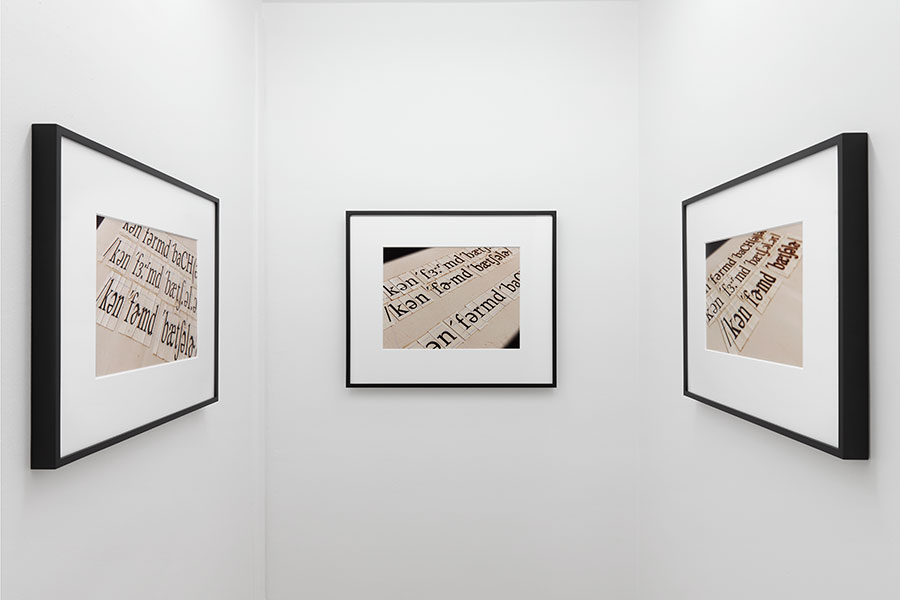The Coded Languages of Artists Larry Johnson and Asha Schechter
A recent exhibition at Jenny’s from one of Los Angeles’s most elusive artists
A recent exhibition at Jenny’s from one of Los Angeles’s most elusive artists

Tucked down a covered walkway on Sunset Boulevard (all the best things in Los Angeles tend to be found somewhere discreet), Jenny’s is showing a new body of work by Larry Johnson with accompanying pieces by Asha Schechter. Though Johnson is practically a cult figure within the Los Angeles art scene, this untitled solo exhibition is his first in the city in ten years. (In)famously elusive (he has no car, no mobile phone, and uses a Hotmail email address), Johnson maintains an aura of secrecy that mirrors his practice, which often incorporates textual and graphic codes.

A series of three photographs, ‘Untitled, Images #1–3’ (2019), are shown inside a recreation of The Vanity East, the second branch of Schechter’s The Vanity gallery – launched in 2011 in his Miracle Mile, Los Angeles apartment – which was housed at 356 Mission from 2013 until the space closed in 2018. It has been replicated at scale here – measuring 2.5 square metres, large enough for one viewer at a time – as a show within a show. The photos are of paste ups, each featuring the same three transliterations of the phrase ‘confirmed bachelor’, which is spelled out using the Sabon serif typeface, designed in 1964–67 by the German typographer Jan Tschichold. Tschichold felt that the modernist theories of his 1928 Die Neue Typographie (The New Typography) had parallels in the Third Reich, from the ruthless restriction of typefaces to the almost militaristic arrangement of lines. In order to combat fascist aesthetics, he returned to an older style, serifs and all. Johnson alludes to this in his own choice of medium, employing a mode of graphic design that has been rendered obsolete by digital media. Taking this idea further, he includes the phrase ‘confirmed bachelor’: a euphemism for a gay man, often used in 20th-century obituaries in the UK, along with the phrase ‘he never married’. Johnson investigates the impulse to conceal with language. We’re always talking in code.

While he may not oppose new technologies, it is evident that Johnson, if ambivalently, is drawn to the past and its hazy glow. He nods to the codes that were once essential to gay life, emphasizing history’s role in shaping the materiality and meaning of language and images. Johnson, quite literally, puts the viewer in the closet: trying to decipher the work, your own reflection becomes visible on the surface of the frame, ‘confirmed bachelor’ pasted across your forehead.

The main gallery features Schechter’s 3D-modelled paper straw prints (Paper Straw, Yippee and Ecostraw, Elephant, both 2019), though a wall covered in wallpaper and a diptych by Johnson takes centre stage. Flaming Big Top (for Charles Nelson Reilly) (2015) comprises purple-striped wallpaper patterned with elephants balancing on rubber balls, reminiscent of the bedroom perhaps belonging to a 1950s goodie-two-shoes with a clean crew-cut. Next to the elephants are images of balloons, fire trucks and, yes, flaming big top circus tents. The latter depict the Hartford circus fire of 1944, which killed 167 people. Constantly revealing then concealing, Johnson juxtaposes newspaper images with light-hearted circus tropes; taking the form of wallpaper, the work pointedly covers up blemishes, smooths over cracks, but reveals them too as if undoing the medium’s original purpose to cover up. A diptych of prints, Untitled (Straight to Hell, Details) (2019), hang on the wallpaper as if attempting to obscure these images of disaster. One depicts a stitched patch, the other a crack revealing a brick wall. Patching over a patch, what a futile gesture.
Main image: Larry Johnson, Flaming Big Top (For Charles Nelson Reilly), 2015, wallpaper, dimensions variable. Courtesy: Jenny's, Los Angeles.
























